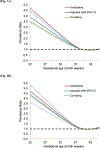Preterm or Early Term Birth and Risk of Autism
- PMID: 34380775
- PMCID: PMC9809198
- DOI: 10.1542/peds.2020-032300
Preterm or Early Term Birth and Risk of Autism
Abstract
Objectives: Preterm birth has been linked with increased risk of autism spectrum disorder (ASD); however, potential causality, sex-specific differences, and association with early term birth are unclear. We examined whether preterm and early term birth are associated with ASD in a large population-based cohort.
Methods: A national cohort study was conducted of all 4 061 795 singleton infants born in Sweden during 1973-2013 who survived to age 1 year, who were followed-up for ASD identified from nationwide outpatient and inpatient diagnoses through 2015. Poisson regression was used to determine prevalence ratios for ASD associated with gestational age at birth, adjusting for confounders. Cosibling analyses were used to assess the influence of unmeasured shared familial (genetic and/or environmental) factors.
Results: ASD prevalences by gestational age at birth were 6.1% for extremely preterm (22-27 weeks), 2.6% for very to moderate preterm (28-33 weeks), 1.9% for late preterm (34-36 weeks), 2.1% for all preterm (<37 weeks), 1.6% for early term (37-38 weeks), and 1.4% for term (39-41 weeks). The adjusted prevalence ratios comparing extremely preterm, all preterm, or early term versus term, respectively, were 3.72 (95% confidence interval, 3.27-4.23), 1.35 (1.30-1.40), and 1.11 (1.08-1.13) among boys and 4.19 (3.45-5.09), 1.53 (1.45-1.62), and 1.16 (1.12-1.20) among girls (P < .001 for each). These associations were only slightly attenuated after controlling for shared familial factors.
Conclusions: In this national cohort, preterm and early term birth were associated with increased risk of ASD in boys and girls. These associations were largely independent of covariates and shared familial factors, consistent with a potential causal relationship.
Copyright © 2021 by the American Academy of Pediatrics.
Conflict of interest statement
POTENTIAL CONFLICT OF INTEREST: The authors have indicated they have no potential conflicts of interest to disclose.
Figures
References
-
- Loomes R, Hull L, Mandy WPL. What Is the Male-to-Female Ratio in Autism Spectrum Disorder? A Systematic Review and Meta-Analysis. J Am Acad Child Adolesc Psychiatry 2017;56(6):466–474. - PubMed
-
- Kolevzon A, Gross R, Reichenberg A. Prenatal and perinatal risk factors for autism: a review and integration of findings. Arch Pediatr Adolesc Med 2007;161(4):326–333. - PubMed


